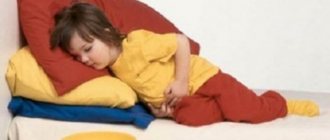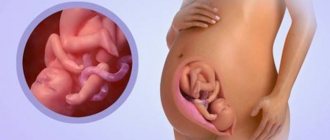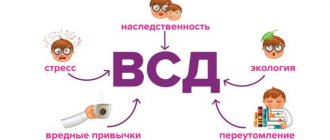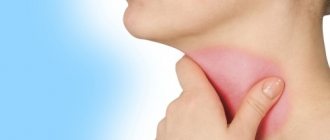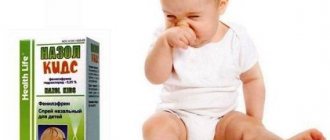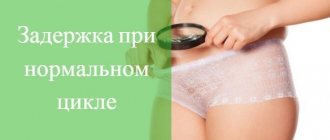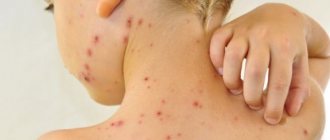Children's ears (specifically, the Eustachian tube) are designed in such a way that many external factors can provoke disorders of this delicate and easily vulnerable organ. It is for this reason that many parents know firsthand about similar problems that occur in 75% of all children under the age of 3 years.
Sharp, completely unexpected pain in the ears, often occurring at night or late in the evening, prevents sleep, worries and causes a lot of suffering. It’s unbearable to watch all this, but what to do if a child has an earache and it’s impossible to visit a doctor right away? How to help the baby, calm him down? First you need to analyze the situation and understand what reasons could cause this pain.
Possible reasons
Parents can figure out why their child has ear pain on their own. To do this, it is necessary to analyze what the child did during the day and what factors could have caused it. He may have suffered from various illnesses over the past week; they can also lead to damage to the organs of the system.
Some external reasons:
- Getting water into the passage while swimming. It can cause tissue inflammation and pain. Cold water is especially dangerous; it leads to serious problems. Dirty liquid with bacteria can also cause inflammation.
- Various injuries, including insect bites, bruises, burns, etc. It is necessary to minimize the consequences of the injury, and the pain will go away after recovery.
- Formation of large wax plugs in the ear. They can irritate tissues and lead to unpleasant sensations. You will need to perform a rinse with a doctor; during the procedures, all contaminants are completely removed.
- Lack of headgear in cold or windy weather. When hypothermia occurs, tissue inflammation can occur, which is why the child’s ear hurts.
- Penetration of a foreign body into the ear canal. Small children can insert small parts of toys into their ears while playing, and often only a specialist can remove them.
There are also internal reasons associated with pathological processes in the body:
- One of the most wasted causes is otitis media. A child experiences pain in the ear; the process is accompanied by severe inflammation. The middle ear can be affected by hypothermia and infections, and the auditory canal by minor injuries. Often otitis media is accompanied by fever.
- Viral infection. Once they enter the bloodstream, viruses quickly spread throughout the body, including the ability to penetrate the organs of the auditory system.
- Fungal infection, including otomycosis. Children with weakened immune systems are especially susceptible to the disease. Natural protection is reduced, microorganisms penetrate tissues more easily and their reproduction begins. Inflammation and pain appear; urgent treatment is necessary to destroy the fungus.
- Inflammation of the Eustachian tube - eustachitis.
- Often, pain occurs at the beginning of a cold, when bacteria reaches the middle ear along with the bloodstream. The cause can also be an untreated disease, if the pathogen has not been completely destroyed and re-reproduction has begun.
- Damage to the auditory nerve is very rare. There is no apparent reason for the pain signal, but the endings convey incorrect information to the brain.
- Pain sensations can be affected by pathologies of neighboring organs. It is necessary to conduct an examination and look for the cause.
- Not so often, but tumors of various types arise in this area.
- Increased intracranial or blood pressure, impaired blood circulation in the brain.
- The pain can only radiate to the ear, for example, with sinusitis, dental problems, mumps, etc.
It is very difficult to determine on your own why a child has ear pain. But as the experience of specialists shows, most cases are associated with otitis media, colds and viral diseases, hypothermia and water ingress. If the discomfort does not go away after first aid and minimal treatment, then do not delay visiting the doctor.
How and with what to treat
In the hospital, the baby will be examined, the real cause of the ear pain will be identified and appropriate treatment will be prescribed. Those parents whose children often have ear pain know that, along with drug therapy, experts often advise using folk remedies. When used correctly, you can speed up your child’s recovery and avoid future complications.
Drug treatment
1. Antibiotics (penicillin injections) are prescribed for 7–10 days for infections and inflammations. If you refuse such therapy, otitis may result in meningitis, mastoiditis, or brain abscess.
2. Ear drops:
- "Otipax" - prescribed for otitis media as an analgesic and anti-inflammatory drug, contains lidocaine, which often causes allergic reactions in children;
- "Otofa" - used to treat acute diseases of the middle ear, contains a powerful antibiotic rifampicin;
- "Garazon" is a medicine with anti-inflammatory and antibacterial effects;
- "Otinum" - has anti-inflammatory and analgesic properties, is contraindicated in children under 1 year of age;
- "Sofradex" is a powerful antibiotic;
- "Remo-Vax" - prescribed to remove sulfur plugs.
3. Treatment with Vaseline oil or hydrogen peroxide is carried out when removing the wax plug from the child’s ear.
4. Rinsing the ear canal is prescribed for fungal infections. Vishnevsky ointment, hydrogen peroxide and pine nut oil are also used for disinfection.
Folk remedies
The most effective recipes at home:
- Heat almond or nut oil until warm, drop 1 drop three times a day into the sore ear.
- Pour dry crushed chamomile (1 teaspoon) with hot water (1 glass), cover, and leave until the infusion becomes warm. Strain. Gently rinse the sore ear twice a day. This folk remedy works especially well for purulent discharge, otitis media and other inflammations.
- Dilute honey with water in equal proportions, bring to a boil, place a thin but wide slice of beetroot in it, and cook for half an hour. Cool, wrap in gauze and apply to the ear that hurts. This compress of beets boiled in honey helps speed up recovery from almost any illness.
- Pour fresh lemon balm (a sprig) with hot water (1 glass), cover, and leave until the infusion becomes warm. Strain. Gently rinse the sore ear twice a day. Melissa infusion can also be given to a child orally, as tea, but only if he is not allergic to it.
- Mix honey and alcohol tincture of propolis in equal proportions. Place 1 drop warm three times a day into the sore ear.
You need to be extremely careful with folk remedies and not use them on the advice of your neighbor grandmothers: only as prescribed by a doctor. Otherwise, you can provoke the development of complications such as deafness, pathologies of the eardrum, and hearing impairment. To avoid them, it is much easier to remember preventative measures rather than to bring the matter to unbearable pain.
Take care of your children's ears: make sure that nothing gets into them, keep your baby's head warm at all times, strengthen his immunity so that no infections affect his little body. This is the only way to get into those lucky 25% of children who don’t know what ear pain is.
New articles
we are in social networks
Irina 10/03/2016 A child has an earache. What to do?
Dear readers, today we will talk about what to do when a child has ear pain. If this happens on an ordinary day, then, of course, any wise parent will go with the child to the clinic or call a doctor at home.
But what if the pain overtook you on a weekend, at night, or at this time you are far from home? An adult can endure it until the morning, but ear pain in a child is a special case! Prolonged suffering will cause trauma to the baby’s delicate psyche, and timely assistance not provided can cause the disease to worsen. Every parent should know how to provide first aid to their baby without causing harm.
Today on the blog I want to present you an article by otorhinolaryngologist Svetlana Ershova. You are already familiar with it from the article Ear Hurts. What to do at home. Svetlana has to work with both adults and children, and today she will tell us how to provide first aid if a child’s ear pain takes you by surprise.
Good day, dear readers of Irina’s blog. If you or your loved ones have small children, then pay attention to the information presented in this article. At the first complaint of ear pain in a child, you need to make an appointment with an otolaryngologist. Only an ENT doctor (not a pediatrician!) using special instruments can examine the eardrum, make a diagnosis and prescribe the correct treatment.
But there is no need to panic if you find yourself far from civilization and your child complains of ear pain. You yourself can help your baby if you know the basic rules of first aid.
In my opinion, the main commandment of a doctor is “Do no harm!” should become a commandment for every parent. You should know the main points when self-medication can harm your baby, and avoid them.
What should you not do if your child’s ear hurts?
- Prescribe antibacterial drugs to your child on your own.
- Clean the ear with tweezers or a cotton swab (cotton swabs are not intended for cleaning ears, but for removing makeup - read on the packaging).
- Place alcohol-based drops into the ear if the eardrum is damaged.
- Make a compress or warm the ear with dry heat without a doctor’s prescription.
Causes of ear pain in children
The structure of a child's ear is somewhat different from that of an adult. Due to the underdevelopment of the cartilage, the auditory (also known as Eustachian) tube in children exits directly into the nasopharynx. Therefore, as soon as the baby begins to have a runny nose, there is a high risk of mucus flowing into the auditory tube and, as a result, the development of otitis media.
To avoid this, you need to prevent the occurrence of colds whenever possible. And if a runny nose continues for more than three days, then be sure to show the child to an otolaryngologist.
Attention! Treat your child’s runny nose in a timely manner and then you will forget about otitis media forever.
To understand how to provide first aid to your baby, you need to know what caused this problem. Ear pain in a child can occur for the following reasons.
- Getting a foreign body or insect into the ear;
- Trauma (barotrauma, fall from a height, damage to the ear canal with a sharp object);
- Water getting into the ear;
- Otitis (inflammation of the ear canal and eardrum);
- Eustacheitis (inflammation of the Eustachian tube);
- Infectious diseases;
- The first signs of a cold (ARVI);
- Sulfur plugs;
- Hypothermia.
How to provide first aid to a child with ear pain?
Parents often cannot determine why their baby has ear pain, so to provide first aid for ear pain, you need to use only those methods that will not harm the little body.
Nasal drops and painkillers
If you complain of pain in the ear, you need to drip vasoconstrictor drops into your nose and give any painkiller that is in your first aid kit. If your baby is allergic, you can give him an antiallergic drug prescribed by his attending allergist.
If an insect gets into your child's ear
If an insect gets into the ear, it does not pose any danger to a healthy ear, much less to the eardrum. But a fly or cockroach can move its legs and touch the eardrum, causing severe pain and dizziness. To alleviate the baby's suffering, you can drip warm oil or alcohol-based drops into the ear and immediately go to see a doctor to remove the insect.
Foreign body in a child's ear and ear injury
If a foreign body gets into the ear, as well as in case of injury or suspected injury, self-medication is strictly forbidden. You need to immediately go to see a doctor, and if this is not possible, then call an ambulance.
In my practice, similar cases often occur; I have to remove various foreign bodies from the ear of children (balls, pieces of eraser, cotton wool). One day, parents brought a 5-6 year old boy with complaints of hearing loss. Upon examination, I found a pea in the ear canal that blocked the ear canal. The pea was removed, and the boy began to hear better.
What to do if you suspect otitis media in a child?
There are times when parents cannot immediately get to the doctor, what should they do then? Let's discuss the moment of instilling boric alcohol into a child's ear. After all, this is an old, proven remedy.
Is it possible to instill boric alcohol for ear pain in a child?
To provide first aid in “field” conditions (when it is not possible to see a doctor), you can use the most common 3% boric acid, it is sold in a pharmacy without a prescription, it is advisable to have this drug in your first aid kit. You need to warm the medicine to room temperature, soak a turunda twisted from cotton wool in it and place it in the sore ear for 2-3 hours.
Despite the fact that many experts have abandoned this drug due to its alleged toxicity, 3% boric acid is an excellent antiseptic and does not cause harm if used correctly. I prescribe this drug to my patients and treat my children with it.
I can assure you that no drug has yet surpassed boric acid in terms of therapeutic effects; the drug has an excellent warming effect and has a local antiseptic effect. Moreover, each bottle contains only 3% boric acid, which is dissolved in 70-degree alcohol. This is a negligible dose that will not harm your baby.
When should you not instill boric alcohol into a child’s ear?
The only reason why boric alcohol should not be used for ear pain is perforation of the eardrum, when purulent or mucous contents are released from the ear. Therefore, if you have examined the baby’s ear and are sure that there is no discharge or perforation of the eardrum from the ear, then you can use 3% boric acid.
How to drop boric alcohol into a child's ear?
You need to heat boric alcohol to a temperature of 25-30 C, moisten a cotton swab and place it in the ear canal, this way the medicine will warm and disinfect the sore ear.
Attention! If you want to help your child cope with ear pain, find an opportunity to immediately show him to the doctor!
I worked in different regions of Russia and I know that huge distances between settlements often do not allow people to receive qualified medical care in a timely manner. For example, we had to hospitalize a child with otitis in one of the regions of the Leningrad region. The parents had to travel about 6 hours to the nearest ENT department, and they did everything possible to alleviate the baby’s condition during this period.
If you find yourself in a similar situation, I hope that my recommendations will help you provide first aid to your baby before he is examined by a doctor.
And finally, I want to invite you to watch a very short video from Dr. Komarovsky. What to do if your child has an earache. Let's briefly summarize our conversation.
With wishes of health to you and your children, Svetlana Ershova, otorhinolaryngologist.
I thank Svetlana for her simple, understandable advice to all of us on what to do if we are faced with the problem of ear pain in a child. And I want to share our story with you.
I experienced severe pain in my daughter’s ear when we first went on a trip with them, or rather flew. And during landing, my daughter just almost screamed and cried so much from pain in her ear. No amount of swallowing and breathing movements helped. And when we went through passport control after landing, the pain never went away.
I still remember this picture. And I didn’t have anything suitable in my first aid kit. As soon as we got to the pharmacy, we immediately bought boric alcohol, I gave it to her, and the pain immediately went away. Then they called the doctor, of course. She prescribed drops for us. And since then, it is precisely this ear that blows out a little, or a runny nose lingers, and immediately bothers her. We know the problem, it is very protective of the ear. Those. This moment of pressure change during landing had such an impact on the eardrum.
Dear readers, I wish everyone only health. Protect yourself, your children and grandchildren from colds, dress for the weather, and be wise. If ear pain bothers your baby, take the time and definitely show him to the doctor!
And for the soul, we will listen to Vladimir Kabatov today. Autumn Woman . So many feelings, harmony, tenderness...
see also
Osteoarthritis of the knee joint: treatment features Ear pain. What to do at home? Shoots in the ear. What to do at home How to make a compress on the ear? Camphor oil in the home medicine cabinet Prominent ears - an annoying defect or a sign of a peculiarity
- Blooming Sally. Beneficial features. Contraindications
- How to brew Ivan tea. Medicinal properties. Application
- Chamomile
- Linseed oil
Parents of more than 70% of children aged 0 to 5 years have encountered such a problem when a child’s ear hurts without fever or with an increase in it. And it’s good if such an attack happened on weekdays, when you can immediately contact your doctor or call him at home.
But in some cases, everything happens at the wrong time: during a vacation at the dacha or in the village, on weekends, at night, when it is not possible to immediately show the child to a doctor and prescribe treatment. Some parents are confused if their child has an earache at night. What to do in this case, how to alleviate his suffering and live until a life-saving consultation with a specialist?
Before you start self-medicating (which, by the way, it would be better not to do) and start doing something to alleviate the baby’s condition, you need to find out what caused this pain and what its cause is.
In addition to the listed causes, ear pain in children can be associated with the anatomical characteristics of the child’s body, as well as genetic predisposition. If mom or dad often encountered the problem of otitis media in childhood, then the child is more likely to be susceptible to the same disease.
Well, don’t underestimate the role of warm hats, especially in windy and cold weather. The ear can simply “inflate”, as people say.
Separately, I would like to focus on a disease such as otitis media, since it is the most common cause of pain in children’s ears.
Otitis as an independent disease in itself appears quite rarely. It is mainly a consequence of frequent acute respiratory viral infections and occurs against the background of adenoviruses, rhinoviruses and various influenza viruses. This type of otitis media is viral in nature. There are also external otitis media, which arise for completely different reasons. In this case, there are two types of external otitis:
- Diffuse – bacterial, allergic or fungal in nature. Bacterial otitis media is caused by staphylococci and Pseudomonas aeruginosa. Moreover, any scratch, pimple or microtrauma can cause bacterial infection with fever and severe pain.
- Limited - usually caused by inflammation of the hair follicle or the formation of a purulent boil. At the same time, the temperature may also rise, the lymph nodes behind the ears may become inflamed, and all this is accompanied by severe pain.
Some parents ask questions: how much does a child’s ear hurt when they have otitis media and what should they put in their child’s ear when there is pain? Depending on the form of otitis and the advanced stage of the disease, you will have to treat your child’s ears from one to three weeks, and the pain will continue until the inflammation is relieved. In particularly difficult situations, treatment may take more than one month.
As for the drops that can be used for otitis media, we will talk about this a little later.
First aid for ear pain
So, what should parents do if they find themselves in a situation where immediate contact with a doctor is impossible for one reason or another, and the child’s ear hurts badly? The first aid that you can give him is to alleviate the symptoms and provide peace to your sick child.
The procedure should be as follows:
- Carry out a thorough examination of the ear. You may be able to detect a foreign object in the ear canal, then you should try to carefully remove it by tilting the child with the affected ear down. But be careful: there is a possibility of pushing this item even deeper.
- If there are no external visible injuries, and the child’s temperature is normal and there are no discharges, then the child’s blood pressure needs to be measured. If it is increased or decreased, then you need to give the baby an appropriate drug that normalizes blood pressure, in doses prescribed for children.
- Try applying gentle pressure to the tragus (the outer cartilage at the bottom of the ear). If the child does not show any concern and is not in pain, then most likely this pain is an echo of some other pain, for example, toothache.
- If ear pain is accompanied by an increase in temperature and/or fluid secretion, then this is a sure sign of an inflammatory process. In this case, you need to give your child an age-appropriate pain reliever or fever reducer. Many medications already combine these two characteristics, for example, children's Paracetamol, Nurofen, Ibuprofen.
- You should also definitely put vasoconstrictor nasal drops into your child’s nose. This should be done in any case, even if there is no hint of a runny nose. The fact is that such droplets will narrow the blood vessels, and this, in turn, will reduce the pressure in the ear canal, and the pain will subside a little.
Many mothers immediately look for something to drip into the ear for pain in their child. We strongly recommend that you do not use anything until you consult a doctor. The baby may have damage (perforation or rupture) to the eardrum. In this case, getting any liquid inside, especially alcohol-based, can only aggravate the situation and lead to irreparable consequences.
Is it possible to apply compresses?
If everything is clear with drops and alcohol solutions (you can’t drop them into a child’s ears without a doctor’s prescription), then the situation with warming compresses, which were especially popular before with our grandmothers and mothers, is completely different. Doctors are not clear on whether they are beneficial. The most important and unconditional truth is that under no circumstances should you make compresses or apply any kind of heating at all if the child has a fever or there is discharge from the ears. If these symptoms are not present, then when a child’s ear hurts, a compress can still alleviate his condition somewhat.
How to make the right compress?
- Take a thick napkin or gauze folded in several layers and make a hole in it under the auricle.
- Take vodka or any medical alcohol, diluted to 40% content, dilute it with a little more water and heat it slightly. There is no point in heating the alcohol solution too much, because the alcohols will evaporate and the compress will have zero benefit.
- Soak gauze or napkin in the heated solution and squeeze thoroughly.
- Lubricate the skin around the ear with baby cream and apply gauze, inserting the auricle into the slot. Place polyethylene or compress paper on top, also with a slot.
- Place a layer of cotton wool on top of all this and secure the structure with a bandage.
This warming compress should be left on for about one hour. Heat will help relieve pain and allow you to calmly wait until you visit a medical facility.
In addition to warming compresses, you can also use just dry heat, that is, simply insulating the child’s ear with cotton wool or a warm scarf or handkerchief. Let us repeat that any heating (and dry heating too) is contraindicated if the child’s body temperature rises or if there is purulent or other discharge from the ear.
Be sure to visit an otolaryngologist.
Even if the pain in the child’s ear has gone away after first aid has been provided, you still shouldn’t relax and let everything take its course. If you do not want complications or any other serious consequences, then seeing a doctor is a must. You can visit your local pediatrician, but it is better to immediately go to a specialized specialist - an otolaryngologist. Only he, using a special medical instrument - an otoscope - can determine the cause of ear pain and prescribe the correct treatment.
In fairly mild forms of the disease, the doctor usually prescribes local drug treatment at home, prescribing anti-inflammatory drugs that relieve pain, lotions, compresses, ointments, etc. Sometimes additional methods are prescribed, for example physiotherapeutic procedures - ultraviolet irradiation or phototherapy. A complex of vitamins may be prescribed to generally strengthen the immune system.
If a bacterial infection is detected, an antibiotic is prescribed for ear pain in a child. Penicillin injections are usually prescribed and given over 7-10 days. Parents should not be afraid of this, because it is much better to drink or take a course of antibiotics than to then deal with the dangerous and sometimes inevitable consequences of their own fears. If you refuse antibiotic treatment, ear disease can develop into meningitis, mastoiditis, or even result in a brain abscess. It is unlikely that you need such sad consequences.
In some cases, when fluid or pus accumulates inside the ear, but it does not come out naturally, hospitalization of the child is recommended, followed by opening the abscess.
Symptoms
Pain can occur unexpectedly and can vary in nature and severity. The child loses his appetite, he is capricious, and complains of discomfort in the ear area. For severe pain, mild analgesics can be used to relieve external manifestations. Body temperature often increases; it is recommended to use antipyretics, such as paracetamol.
If symptoms occur, parents can perform a self-examination and try to determine possible causes:
- Initially, sit the child in a chair and calm him down. Take a flashlight for better lighting and carefully examine the ear canal. If a foreign body is stuck in it and it is not deep, then you need to try to carefully remove it. The child may tilt his head and shake it. Do not use sticks or tongs; if the object cannot be removed on your own, then call a doctor.
- You can gently press on the small cartilage in your ear. If the child does not experience pain under external influences, then the problem is in a completely different organ.
- Be sure to measure your temperature. Its increase indicates inflammatory processes, with a high probability that the child has otitis media.
- It would be a good idea to measure your blood pressure. Its increase can be one of the causes of pain in this area.
- Pus appears quite rarely; if you notice small white discharge during examination, then it indicates an infectious process.
- If the ear is swollen or a blue tint appears, injury or an insect bite may be suspected. In some children, the substances injected during bites cause severe local allergies.
- If a child has an earache and the process is accompanied by itching, then the canal is affected by a fungus.
Signs and symptoms of ear pain in children
Determining whether a newborn baby’s ear really hurts is not easy. A baby can be capricious for various reasons. Mom should carry out a simple procedure: gently pull the earlobe or lightly press on the cartilaginous tubercle in front of the auditory opening. If the source of pain is localized inside the ear, the baby will cry. The ears of infants suffer especially from pain due to otitis media. You can understand that a baby is experiencing excruciating pain in the ears by the following signs:
- restless and interrupted sleep;
- during sleep, the baby tries to lie on the big ear to relieve pain
- reluctance to eat, weak sucking or chewing movements of the mouth due to discomfort;
- crying and jerking when eating;
- increased body temperature;
- rubbing ears with fingers;
- yellowish purulent discharge from the ear canal, which is noticeable on the pillow after sleep.
Help a child
What to do when pain occurs? If it is small and there are no serious manifestations, then you can wait until the morning and take the baby to the doctor. But in case of serious problems, it is better to call an ambulance so that specialists can conduct an examination and take action.
Alcohol compress for warming a child's ear with pain
You can provide the following help to your child:
- Call a doctor; before he arrives, you can give simple analgesics that do not have a powerful effect on the body.
- An alcohol compress will help warm up the ear and relieve pain. Take gauze, make a small hole in it and moisten it with alcohol. It is put on the ear, wrapped in cellophane and a warm scarf on top.
- At high temperatures, it is recommended to use antipyretic drugs; they will help alleviate the baby’s condition.
- In many children, ear inflammation and otitis media occur quite often during the winter season. It is necessary to purchase drops prescribed by the doctor and use them when pain occurs.
But don’t just do self-treatment; it’s better to invite your local doctor the next day. He will conduct an examination, make a diagnosis and prescribe medications. After a few days, all unpleasant sensations will completely disappear.
Some parents know that if a child has an earache, doctors often recommend using folk remedies along with medications. Specialists do not officially announce this, because due to their duties they are prohibited from using such methods of treatment. But as doctors’ extensive experience shows, many folk remedies really work well and allow you to achieve a positive result.
What not to do if your child has ear pain
- Use sticks to clean out the ear canal.
- Instill if there is discharge from the ear.
- Rinse the ears using syringes or enemas.
- If there is discharge, do not warm your ears.
In conclusion: there are a large number of techniques available to help get rid of even severe pain. But here it is worth noting that you cannot ignore a trip to the pediatrician - you will not be able to find out the cause of the disease on your own without examinations, you need to be sure that the child does not have pathological abnormalities.
Treatment at home
Do not limit yourself only to folk remedies and do not self-medicate at home without consulting a specialist. For serious problems, medications will be required, only they will allow you to quickly cope with the disease. Folk remedies can be used as an auxiliary option or a temporary measure.
- In case of inflammatory processes and otitis media, regular warming helps a lot. To do this, you can use a special blue lamp; such devices were widely used previously. The device turns on, is brought at a certain distance to the ear and warms up.
- Another option is to pour salt into a cloth bag and heat it up. It maintains the set temperature for a long time and transfers heat. The bag is applied to the ear and helps fight pain.
- You can also use a regular heating pad with hot water. All these methods have the same principle of action - heating occurs, inflammation and pain are reduced. But using these methods is not recommended for infectious otitis media; an increase in temperature can cause accelerated bacterial growth.
- Nut or almond butter performs well. Before use, warm it up and instill 1 drop. The procedure is repeated three times a day until complete recovery.
- Another recipe suggests mixing honey and water in equal quantities and bringing to a boil on the stove. Cut a wide and thin slice of beets, place in a bowl and boil for thirty minutes. After evaporation, pour the mixture into gauze and apply to your ear.
- Take propolis tincture and mix it with the same amount of honey. The product is instilled one drop three times a day.
- You can add a glass of hot water to a lemon balm sprig. Wait until the temperature drops and the liquid becomes warm. It is necessary to rinse the ear with it, the procedure is repeated twice a day. In the absence of an allergic reaction, it is recommended to drink the composition as tea.
- You can brew a teaspoon of chamomile with a glass of boiling water. Wait until the liquid becomes warm and use it to rinse. The procedure is carried out twice a day, the infusion perfectly fights germs and reduces inflammation.
How do your ears hurt with an ear infection?
When the Eustachian tube, which connects the middle ear to the back of the nose, becomes blocked and fluid accumulates in the middle ear, viruses or bacteria can multiply in the fluid, and pain is caused not only by increased pressure in the middle ear, but also by the waste products of these microorganisms (pus). . This disease is called acute otitis media. Typically, ear infections occur as a complication after or during a child's exposure to a viral upper respiratory tract infection. Otitis media is more common in winter in children attending kindergarten or school. If otitis media is bacterial in nature, antibiotics are used for treatment. Antibacterial agents are not used to treat viral otitis.
Traditional methods of relieving pain
Many doctors recommend folk remedies that promote a speedy recovery. The most common methods:
- Camphor oil must be heated and, while warm, a few drops should be instilled into each ear.
- Geranium leaves need to be kneaded in your hand, rolled up and inserted into the ear.
- Centaury grass. It must be steamed, wrapped in linen cloth and applied to the sore ear.
- Propolis and olive oil must be mixed in a 1:2 ratio, applied to a cotton swab and applied to the ear for 2 hours.
- Propolis extract with honey should be mixed in a 1:1 ratio. You need to instill 2 drops at night.
- You can squeeze oil out of walnuts using a garlic press. Instill the resulting liquid 2 drops at a time.
Otitis externa: methods of prevention and treatment
Often, painful sensations can be associated with inflammatory processes occurring in the external auditory canal. The following signs can help distinguish external otitis media from otitis media: pain intensifies when opening the mouth or when pulling the auricle slightly posteriorly; wounds and rashes can also be detected; the child may complain of itching in the ear.
Most often, otitis externa can be caused by:
- Excessive ear hygiene. This occurs with daily use of ear sticks, which leads to a decrease in the amount of wax and a decrease in its protective function.
- Injury.
- Frequent entry of liquid into the ear.
Of course, you need to immediately consult an otolaryngologist. Most often, specialists prescribe the following treatment:
- Medicines: antibiotics, anti-inflammatory drugs and antiseptics.
- Additional methods are also used: physiotherapy, warm compresses and a multivitamin complex.
- In severe cases, hospitalization may be necessary for surgery (if it is necessary to open the abscess).
How to help a child
What to do if your child has severe ear pain inside?
First of all, if a child has an earache, you must provide first aid yourself before the pediatrician arrives. It is as follows:
- Give your child an age-appropriate pain reliever. It is better to use a medicine you know.
- Apply a compress to the ear: the first layer is gauze soaked in alcohol; the second layer is cellophane (these two layers must have a cutout for the ear); the third layer is a warm scarf with which you need to wrap your ear.
- Antipyretics can be given only in critical cases, if nothing else can be done to improve the child’s condition.
- If you have a fever, you can also soak a cotton swab in boric acid and place it in the ear.
- Give your baby plenty of fluids to drink.
- If this situation has not arisen for the first time, then you can use the drops that have already been used to treat your baby.
- The most important thing is to provide moral support to the baby until the doctor arrives. It is necessary to try to make the child forget about his pain for at least a few minutes, even if there is a sleepless night ahead. Remember that this situation is much more difficult for the baby than for you.
How to treat if a child has ear pain
In the hospital, the baby will be examined and the exact cause of the pain will be determined. Most often, doctors recommend using the following medications:
- If there is bacterial damage, antibiotics are used (usually penicillin injections).
- Ear drops:
- "Otipax" - has anti-inflammatory and analgesic effects. Prescribed for otitis media.
- "Garazon" - has antibacterial and anti-inflammatory properties.
- "Otofa" - has a powerful antibacterial effect.
- "Sofradex " - has antibacterial properties.
- "Otinum" - has analgesic and anti-inflammatory effects, not for use in children under 1 year of age.
- "Remo-Vax" is a product for removing wax plugs.
- After removing the wax plug from the baby’s ear, treatment with hydrogen peroxide or petroleum jelly is prescribed.
- For otomycosis, rinsing of the external auditory canal and hydrogen peroxide are prescribed. You can also use pine nut oil and Vishnevsky ointment.
